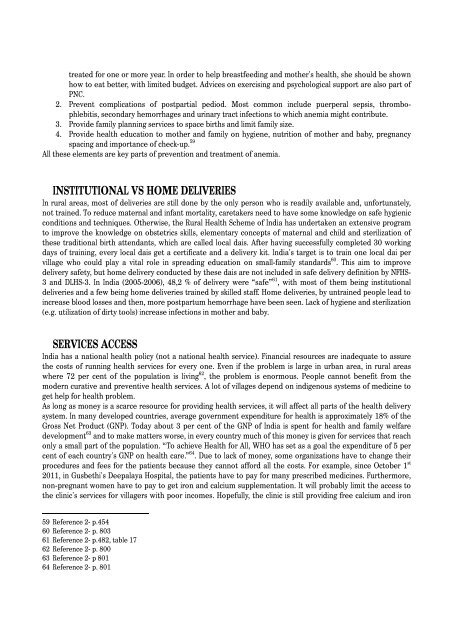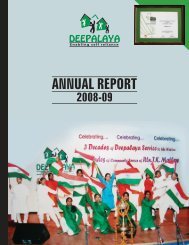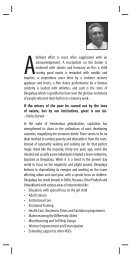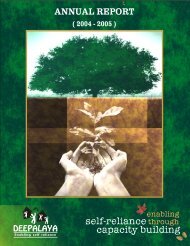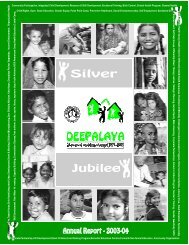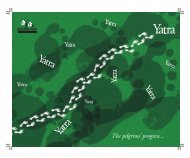Report 2011 - Deepalaya
Report 2011 - Deepalaya
Report 2011 - Deepalaya
Create successful ePaper yourself
Turn your PDF publications into a flip-book with our unique Google optimized e-Paper software.
treated for one or more year. In order to help breastfeeding and mother's health, she should be shown<br />
how to eat better, with limited budget. Advices on exercising and psychological support are also part of<br />
PNC.<br />
2. Prevent complications of postpartial pediod. Most common include puerperal sepsis, thrombophlebitis,<br />
secondary hemorrhages and urinary tract infections to which anemia might contribute.<br />
3. Provide family planning services to space births and limit family size.<br />
4. Provide health education to mother and family on hygiene, nutrition of mother and baby, pregnancy<br />
spacing and importance of check-up. 59<br />
All these elements are key parts of prevention and treatment of anemia.<br />
INSTITUTIONAL VS HOME DELIVERIES<br />
In rural areas, most of deliveries are still done by the only person who is readily available and, unfortunately,<br />
not trained. To reduce maternal and infant mortality, caretakers need to have some knowledge on safe hygienic<br />
conditions and techniques. Otherwise, the Rural Health Scheme of India has undertaken an extensive program<br />
to improve the knowledge on obstetrics skills, elementary concepts of maternal and child and sterilization of<br />
these traditional birth attendants, which are called local dais. After having successfully completed 30 working<br />
days of training, every local dais get a certificate and a delivery kit. India's target is to train one local dai per<br />
village who could play a vital role in spreading education on small-family standards 60 . This aim to improve<br />
delivery safety, but home delivery conducted by these dais are not included in safe delivery definition by NFHS-<br />
3 and DLHS-3. In India (2005-2006), 48,2 % of delivery were “safe” 61 , with most of them being institutional<br />
deliveries and a few being home deliveries trained by skilled staff. Home deliveries, by untrained people lead to<br />
increase blood losses and then, more postpartum hemorrhage have been seen. Lack of hygiene and sterilization<br />
(e.g. utilization of dirty tools) increase infections in mother and baby.<br />
SERVICES ACCESS<br />
India has a national health policy (not a national health service). Financial resources are inadequate to assure<br />
the costs of running health services for every one. Even if the problem is large in urban area, in rural areas<br />
where 72 per cent of the population is living 62 , the problem is enormous. People cannot benefit from the<br />
modern curative and preventive health services. A lot of villages depend on indigenous systems of medicine to<br />
get help for health problem.<br />
As long as money is a scarce resource for providing health services, it will affect all parts of the health delivery<br />
system. In many developed countries, average government expenditure for health is approximately 18% of the<br />
Gross Net Product (GNP). Today about 3 per cent of the GNP of India is spent for health and family welfare<br />
development 63 and to make matters worse, in every country much of this money is given for services that reach<br />
only a small part of the population. “To achieve Health for All, WHO has set as a goal the expenditure of 5 per<br />
cent of each country's GNP on health care.” 64 . Due to lack of money, some organizations have to change their<br />
procedures and fees for the patients because they cannot afford all the costs. For example, since October 1 st<br />
<strong>2011</strong>, in Gusbethi's <strong>Deepalaya</strong> Hospital, the patients have to pay for many prescribed medicines. Furthermore,<br />
non-pregnant women have to pay to get iron and calcium supplementation. It will probably limit the access to<br />
the clinic's services for villagers with poor incomes. Hopefully, the clinic is still providing free calcium and iron<br />
59 Reference 2- p.454<br />
60 Reference 2- p. 803<br />
61 Reference 2- p.482, table 17<br />
62 Reference 2- p. 800<br />
63 Reference 2- p 801<br />
64 Reference 2- p. 801


